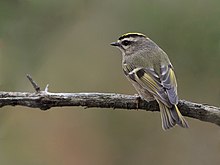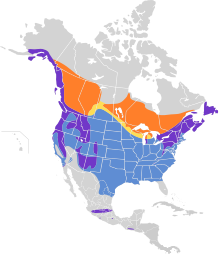Loading AI tools
Species of bird From Wikipedia, the free encyclopedia
The golden-crowned kinglet (Regulus satrapa) is a very small songbird in the family Regulidae that lives throughout much of North America.
| Golden-crowned kinglet | |
|---|---|
 | |
| Scientific classification | |
| Domain: | Eukaryota |
| Kingdom: | Animalia |
| Phylum: | Chordata |
| Class: | Aves |
| Order: | Passeriformes |
| Family: | Regulidae |
| Genus: | Regulus |
| Species: | R. satrapa |
| Binomial name | |
| Regulus satrapa Lichtenstein, MHC, 1823 | |
 | |
| Range map of the golden-crowned kinglet. The breeding range is highlighted in orange, the migration range in yellow, the non-breeding range in blue, and the year-round range in purple. | |

Adults are olive-gray on the upperparts with white underparts, with thin bills and short tails. They have white wing bars, a black stripe through the eyes and a yellow crown surrounded by black. The adult male has an orange patch in the middle of the yellow crown. The juvenile is similar to the adult, but with a browner back and without the yellow crown.[2] This is one of the smallest passerines in North America. Its length, at 8 to 11 cm (3.1 to 4.3 in), is probably the shortest of any American passerine.[citation needed] Its weight, averaging 6.1 g (0.22 oz) for females and 6.3 g (0.22 oz) for males and ranging from 4.5 to 7.8 g (0.16 to 0.28 oz),[3] is similar to the American bushtit[4] and black-tailed gnatcatcher.[5] The golden-crowned kinglet has a wingspan of 5.5-7.1 in (14-18 cm).[6]
The golden-crowned kinglet is insectivorous, foraging in trees or shrubs, where it eats insects (especially caterpillars), insect eggs and spiders.[7] It produces a series of high-pitched calls on a single note, and tends not to fear human approach.[citation needed] Its nest is a well-concealed hanging cup suspended from a conifer branch.[8]

The golden-crowned kinglet is a widespread migratory bird throughout North America. Its breeding habitat is coniferous forests across Canada, the northeastern and western United States, Mexico and Central America. It migrates to the United States in the non-breeding season. Some birds are permanent residents in coastal regions and in the southern parts of their range. Northern birds remain further north in winter than the ruby-crowned kinglet.

The kinglets are a small group of birds sometimes included in the Old World warblers, but frequently given family status,[9] especially as recent research showed that, despite superficial similarities, the crests are taxonomically remote from the warblers.[10][11] The names of the family, Regulidae, and its only genus, Regulus, are derived from the Latin regulus, a diminutive of rex, "a king",[12] and refer to the characteristic orange or yellow crests of adult kinglets.
There are three migratory subspecies in the United States and Canada, differing in size, bill length, back and rump colours, wing bar width and colour, and length of supercilium:[13]
The subspecies "amoenus" has been synonymised with apache, as the distinctions between these populations are obscured by individual variation.[13]
Two other (non-migratory) subspecies occur south of the bird's core range, although these are weakly differentiated from each other and so are perhaps best synonymised:[14]
Hybridization with ruby-crowned kinglets has been reported to have possibly occurred.[13]
Seamless Wikipedia browsing. On steroids.
Every time you click a link to Wikipedia, Wiktionary or Wikiquote in your browser's search results, it will show the modern Wikiwand interface.
Wikiwand extension is a five stars, simple, with minimum permission required to keep your browsing private, safe and transparent.